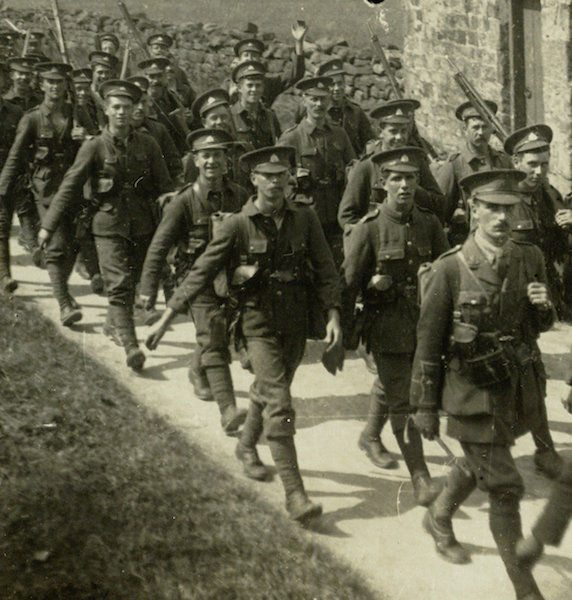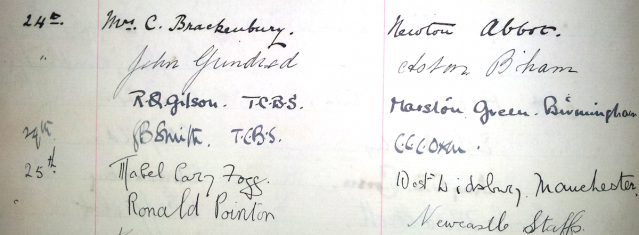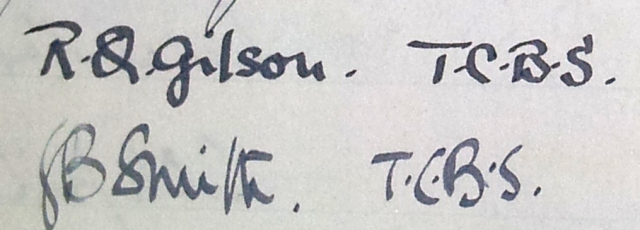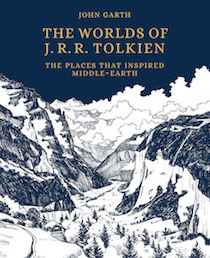- Best Article, Tolkien Society Awards 2016
- Also available in Spanish and Portuguese.
One hundred years ago today, four young men convened in an English town, not having seen each other for some time. What makes this trivial event significant is that one of them was J R R Tolkien, and the four comprised his first ‘fellowship’, the TCBS – a group with a profound impact on his youth and on his legendarium. This reunion, on 25 and 26 September 1915, was the last time the four met before they were separated, permanently, by war.
The reason for today’s article is the discovery of a small archival treasure marking the event. The signatures of two TCBS members, Geoffrey Bache Smith and Robert Quilter Gilson, have been discovered in the guest book at the birthplace of Samuel Johnson, the author and lexicographer. (Tolkien, of course, looked rather further back for his inspirations, to the Middle Ages and beyond; though his Times obituarist did note that he had a ‘Johnsonian horror of going to bed’.)
Both Smith and Gilson were fascinated by the era – Smith by its literature, Gilson by its architecture. On a recent visit to Bath, as Gilson wrote,
we have immersed ourselves in an eighteenth century atmosphere — Bath does it of its own accord — and conducted most of our conversation in Johnsonian and Gibbonian periods. GB Smith composes excellent Gibbon. He is at present reading Amelia and revelling in it. I very quickly catch his enthusiasm for that extraordinary century. It really did know how to build private houses.
As well as their addresses – Marston Green near Birmingham for Gilson and Corpus Christi College, Oxford, for Smith – they append ‘T.C.B.S.’ to their names. It is a poignant sign of the value they placed in their fellowship.
The friendships had been formed at King Edward’s School, Birmingham, coalescing in 1911 into a kind of secret society that brewed clandestine teas in the library office, where Tolkien was in charge. They would also meet in the tea rooms of Barrow’s Stores. So they had called themselves the Tea Club and Barrovian Society, eventually just the ‘TCBS’. Though its members had dominated school cultural life – the debating and literary societies, and so forth – the youthful TCBS had been at least as much about drollery and japes. When Tolkien left for Oxford University, he formed another club there, the Apolausticks, in a similar vein; but the TCBS continued to meet.

R Q Gilson, at right and facing the camera, marches with soldiers from his 11th Suffolks battalion during training (Image courtesy of Julia Margretts)
Under the shadow of war, from 1914 the TCBS had acquired a powerful sense of itself as a serious force, as I tell in Tolkien and the Great War. It had halved its numbers to just four – Tolkien, Gilson, Smith and Christopher Luke Wiseman, who had sealed their bond with a December 1914 meeting dubbed ‘the Council of London’. They were all four exceptional young men, and they were rapidly forming the idea that somehow they could change the world for the better through art and writing. For Tolkien, who had just been making his first steps at serious creative writing (see my articles here and here), the Council of London changed everything.
Steps became strides, and 1915 had seen him laying the foundations of Middle-earth in poems and an invented ‘Elvish’ language. He wrote to Smith later, ‘That Council was as you know followed in my own case with my finding a voice for all kinds of pent up things and a tremendous opening up of everything for me:— I have always laid that to the credit of the inspiration that even a few hours with the four always brought to all of us.’ He shared his early poems with the TCBS, and it is quite clear they had a deep though indefinable influence on aspects of his Middle-earth writings.
By September 1915 all four were undergoing military training for the war that had been raging for more than a year. Wiseman was in the Navy. Smith and Gilson had enlisted in the Army much earlier than Tolkien, and knew that it could not be long before they were sent to the front to fight. Tolkien’s training battalion, the 13th Lancashire Fusiliers, was based at Whittington Heath near Lichfield, Staffordshire. Gilson had written to him from hospital, where he was recovering after a serious bout of influenza. Here I’ll let my book Tolkien and the Great War take up the tale:
Tolkien now sent him a second sheaf of his poems and Gilson, feeling revivified by the TCBSian spirit, promised to criticise them. Abruptly he had learned he was about to be released from hospital, and was going on leave…. He determined to visit Tolkien at Lichfield, and sent telegrams summoning Smith and Wiseman as well. ‘At times like this when I am alive to it, it is so obvious that the TCBS is one of the deepest things in my life,’ he told Tolkien, ‘and I can hardly understand how I can be content to let slip so many opportunities.’ Wiseman came up from Greenwich, where he had begun his navigation course, and Smith travelled from Salisbury Plain, where the Salford Pals [his battalion, the 19th Lancashire Fusiliers] were now encamped. Arriving first, Smith and Gilson — now no longer the comfortably rounded figure of school and college days — visited the cathedral and the birthplace of Dr Johnson. Tolkien joined them, and finally Wiseman, and the four stayed at the George Hotel for an evening of ‘that delightful and valued conversation which ever illumines a council of the TCBS’, as Smith put it. The four were assembled for the last time. It was Saturday 25 September. In northern France, in a foretaste of the battle which lay in store for three of the TCBS, the British army at Loos (including the first Kitchener volunteers) launched an assault so disastrous that, as the attackers turned to retreat, the German machine gunners who had mowed down eight thousand men ceased firing, finally overcome with pity.
Two of Tolkien’s friends from Exeter College’s Apolausticks – Max Windle (Michael William Maxwell Windle) and Osric Staples – died on 25 September 1915 at Loos. It was a harbinger of the losses that lay ahead for the TCBS itself. Rob Gilson was killed on the first day of the Battle of the Somme, 1 July 1916. G B Smith, a poet who perhaps shared Tolkien’s youthful vision most closely, died on 3 December 1916 of wounds sustained from a shell burst three days before. He was several miles behind the Somme front line, organising a football match for his men.
Many months earlier, ahead of a perilous night patrol in which he thought he might be ‘scuppered’, Smith had written what he thought might be his final letter to his friend, declaring himself ‘a wild and whole-hearted admirer’ of Tolkien’s work; we might now call him the first ‘Middle-earth fan’. Fearing the worst for the night patrol, Smith was defiant:
… the death of one of its members cannot, I am determined, dissolve the TCBS.… Death can make us loathsome and helpless as individuals, but it cannot put an end to the immortal four!
 Smith’s and Gilson’s signatures were found by Joanne Wilson of the Samuel Johnson Birthplace Museum after an enquiry by Marty Smith of the Ridware History Society, who had heard about the ‘Council of Lichfield’ in a talk by David Robbie, an expert on Tolkien’s time in Staffordshire. It is intended that the visitor book will go on display in an exhibition about Tolkien in Staffordshire being planned by the Haywood Society, the Staffordshire Library Service and the Museum of Cannock Chase for next year.
Smith’s and Gilson’s signatures were found by Joanne Wilson of the Samuel Johnson Birthplace Museum after an enquiry by Marty Smith of the Ridware History Society, who had heard about the ‘Council of Lichfield’ in a talk by David Robbie, an expert on Tolkien’s time in Staffordshire. It is intended that the visitor book will go on display in an exhibition about Tolkien in Staffordshire being planned by the Haywood Society, the Staffordshire Library Service and the Museum of Cannock Chase for next year.
I can’t account for the date ‘24th’ next to signatures: it’s perfectly clear from their correspondence that Smith and Gilson arrived on 25 September and visited the Johnson birthplace that day. The entry stands as a quiet testimony to a bond of fellowship that underpinned the beginnings of Tolkien’s Middle-earth – and to two young men who did not survive to see his work reach fruition.
- I’d like to thank David Robbie for alerting me to the guestbook entries; the Samuel Johnson Birthplace Trust for allowing me to reproduce them; and Julia Margretts for permission to use the Gilson photograph.
- I’d also like to thank the members of the Tolkien Society who voted this Best Article in their 2016 awards. It comes after another article of mine, ‘Tolkien and the Boy who didn’t Believe in Fairies’, was named Best Article in the Tolkien Society Awards 2014.






Reblogged this on Mouzafphaerre.
Reblogged this on A Pilgrim in Narnia and commented:
A very cool post from Tolkienist John Garth for today’s Feature Friday!
Reblogged this on The Oddest Inkling and commented:
Here is an excellent post by John Garth — I’m serving as his preceptor for a course called “Tolkien’s Wars and Middle-earth” at Signum University this semester. Do check out his work, especially his amazing book “Tolkien and the Great War”!
Thank you for this! I wonder if Smith and Gilson’s “enthusiasm for that extraordinary century” inform in a new way the Augustan qualities and interactions attended to by Clive Tolley’s “Tolkien’s „Essay on Man“: A look at Mythopoeia”, Inklings Jahrbuch 10 (1992)? And, for that matter, a strand in the friendships with Johnsonian Jack and Saint-Simonian Warnie Lewis?
Thanks for your various comments, David. It’s very difficult to say how far Smith and Gilson managed to draw Tolkien into their enthusiasm for the 18th century, or whether the effect was lasting. Clearly the era has not been a primary focus for Tolkienian research. I don’t know Tolley’s paper, but I’ll certainly look it up and ponder your question.
I just caught up with the fact, from his online CV at the University of Turku, that he later published a “Revised and corrected edition in The Chesterton Review: The Journal of the Chesterton Society 28 (2002):79–95”.
Hmm… ‘The Voyage of Éarendel the Evening Star’, J.R.R. Tolkien dated 24 September 1914: a Thursday. Among other years in which 24 September falls on a Thursday is 1987. Night 69 in the Notion Club Papers falls on the last Thursday in September 1987: but the date there is “25”. The TCBS begin what turns out to be their last get-together on a 25 September (Saturday in 1915) – and Tolkien presumably later learns that it was upon that very day that his other, Apolaustick, friend, Osric Staples, died. A.A. Lowdham’s father was originally ‘Oswin’, then, Edwin son of Oswin: named after? – or coinciding with the name of? – King St. Oswin, son of King Osric. Is all – or much of? – this coincidental, or is something going on here? (For what it is worth, 25 September falls on Thursday in 1924, 1941, and 1947, while, after 1914, 24 September falls on Thursday again in 1924, 1931, 1936, and 1942.)
Thank you for your thought-provoking comments, David. There are other factors that make this inquiry seem initially promising. As I’ve noted in a previous blog post, the facsimile title page for ‘The Notion Club Papers’ is dated 2014 – a century after Middle-earth was born in the 1914 poem ‘The Voyage of Éarendel the Evening Star’; and Lowdham, the surname of the character who echoes Tolkien’s own memory of first encountering the Old English name Éarendel, is also the name of a village very close to Gedling, where that poem was written. So much, I think, suggests deliberate (albeit private) signposting of the 1914 poem. Then, too, there is the fact that ‘The Notion Club Papers’ included, at one stage, references to real members of the Inklings, which makes a reference to an Apolaustick seem feasible.
However, I can make nothing of the further points you’ve raised. Every date in ‘The Notion Club Papers’ is in error, as Tom Hillman noted in a recent blog post. The story says the meetings were held on Thursdays, but the relevant dates for the real 1987 fell on Fridays.
Did Tolkien even use a calendar? He could easily have begun with an arbitrary date, 20 February (for the night he first described, Night 60), and calculated the rest without recourse to a calendar. Yes, I suspect he was rather casual in his dates in this instance – writing, as he was, what constitutes draft material, probably in rather a rush in 1945 and 1946, while conscious that he ought to be working on The Lord of the Rings. When in manuscript C he added an earlier meeting (Night 54), and called it 16 November 1986, he was even further out of his reckoning: that date actually fell on a Saturday. So even if we forget about 1986 and 1987, there’s no way (short of an intervening calendar reform) that this fictional November date can be reconciled with those in the following fictional year.
I think Tom is probably right to guess that Thursday was picked for the meetings because that’s the night the Inklings met in C S Lewis’s rooms at Magdalen College. But the fact that 24 September 1914 was also a Thursday seems likely to be a coincidence. If Tolkien wasn’t using a perpetual calendar to establish the correct dates for 1987, it stands to reason that he wouldn’t be using one to check a weekday for 1914 (a detail I very much doubt he’d remember it 30-odd years later).
Given what I see as other, deliberate pointers to the 1914 Éarendel poem, it’s feasible that Tolkien did want the momentous events of Night 69 to fall on the anniversary, but when he came to it discovered that his scheme of ‘1987’ dates wouldn’t allow it, so chose the nearest Thursday, 25 September. Or it’s possible – just – that in this Inklings-inspired story he wanted to commemorate the last meeting of the T.C.B.S. on 25 September 1915, a date that the Battle of Loos may have helped imprint on his memory. In which case the mismatch of weekday need not have mattered to him.
As for Osric Staples, we can be sure that in his youth Tolkien was struck by his distinctively Anglo-Saxon name (not to mention their shared South African birth). But we can’t be sure he knew the date of Staples’ death: I’m aware of no evidence that he stayed in touch with any of his friends from Exeter College undergraduate days, apart from Allen Barnett, the American Apolaustick. The name Oswin recurs from ‘The Lost Road’ and was part of Tolkien’s sequence Oswin – Alboin – Audoin: god-friend, elf-friend, bliss-friend: all significant names in reference to key aspects of the legendarium. I don’t think we need refer either to St Oswin of Deira or beyond him, via his father Oswin, to Osric Staples. Another Exeter contemporary was Trevor Oliphant, but we don’t need him to account for Tolkien’s interest in oliphaunts.
Thank you for such a detailed, informative, and thoughtful response!
Something interesting about Night 54 is that it fits 1944 – could that be any kind of evidence as to when he was working on one or another draft – C itself, or something earlier? The reference to Williams’s play, The House of the Octopus, in A and B must have been meant as a bit of teasing Williams could hear. And I suppose it’s omission in D (and, I take it, C) would follow his sudden, unexpected death. The “second typescript”, if not made by Tolkien, might conceivably been made by Williams’s friend, Margaret Douglas, about whom Tolkien writes to Christopher on 30 September 1944 as “typing Ring” (Letter 82). (Unfortunately, I don’t know anything by heart about the composition and publishing history of The House of the Octopus, and what notes I have will take some ‘archive archaeology’ to consult. But perhaps Grevel Lindop’s biography will set out a lot, when it appears on 29 October!) For what it is worth, the ‘content’ of night 54 reminds me a bit of 30 November 1939 as reported to Warnie by C.S. Lewis on 3 December.
Nights 60 and 61 fit 1936, 1941, and 1947, and Nights 62-70 fit 1924, 1941, 1947, and 1952. While Wormald and Borrow concluding in 2014 that they “were written sixty years ago, or more” and Green adding, “The forward dating might have been adopted as an additional screen” move me to look to the 1940s, it is not obvious to me that any of these ‘fits’ for days and dates mean anything – 1941 being, I presume, too early for any of the drafting, and 1947 late, even for F.
Oops!: Thursday, 25 September 1925!
With the admiration of Tolkien’s work in mind – presumably including ‘The Voyage of Éarendel the Evening Star’ – do we know if Tolkien and his circles were aware of Franz Cumont’s recent lectures, Astrology and Religion Among the Greeks and Romans (1912) – with his acknowledgement of Oxonian help (p. v)? (Several scans are in the Internet Archive.)
Pingback: Elendilion – Tolkienowski Serwis Informacyjny » Blog Archive » Ogłoszono zwycięzców Tolkien Society Awards 2016
I just noticed that the annotation in the collected letters to letter no. 5 gives the month of the last meeting of the TCBS as December. I suppose that’s an error, and should be September?
That reference is to a meeting on the weekend of 12–13 December 1914, at the home of Christopher Wiseman’s family in Wandsworth, London – “the Council of London”, as the T.C.B.S. members called it. At that point, Smith and Gilson had only just been commissioned as army officers, while Tolkien and Wiseman were still completing their undergraduate courses. By September 1915 and “the Council of Lichfield”, all four were in the armed forces (Wiseman in the Navy), and Smith and Gilson were awaiting imminent embarkation orders for the front. It does not seem that the four managed to meet together in between, or at any other point during the war.
Pingback: TCBS Article wins Best Article at Tolkien Society Awards 2016 : Great War Staffordshire
Pingback: Os “Quatro Imortais” de Tolkien se encontram pela última vez - Tolkien Brasil | Tolkien Brasil
Pingback: JRRVF | Tolkien et la Somme – Le Centenaire – 18 juin 1916
Pingback: 1st July 1916 – Castle Bromwich and Marston Green | Solihull Life
Pingback: Winners of the Tolkien Society Awards 2016 announced – The Tolkien Society
Pingback: Ganadores de los premios de The Tolkien Society 2016 | El Anillo Único
Pingback: Famous faces at Johnson’s Birthplace – The Samuel Johnson Birthplace Museum Blog
Pingback: I vincitori dei Tolkien Society Awards 2016. Alan Lee nuovo socio onorario! – TOLKIEN CON TE, OGNI GIORNO
Pingback: The dream of Geoffrey Bache Smith | John Garth